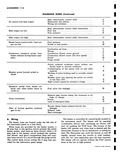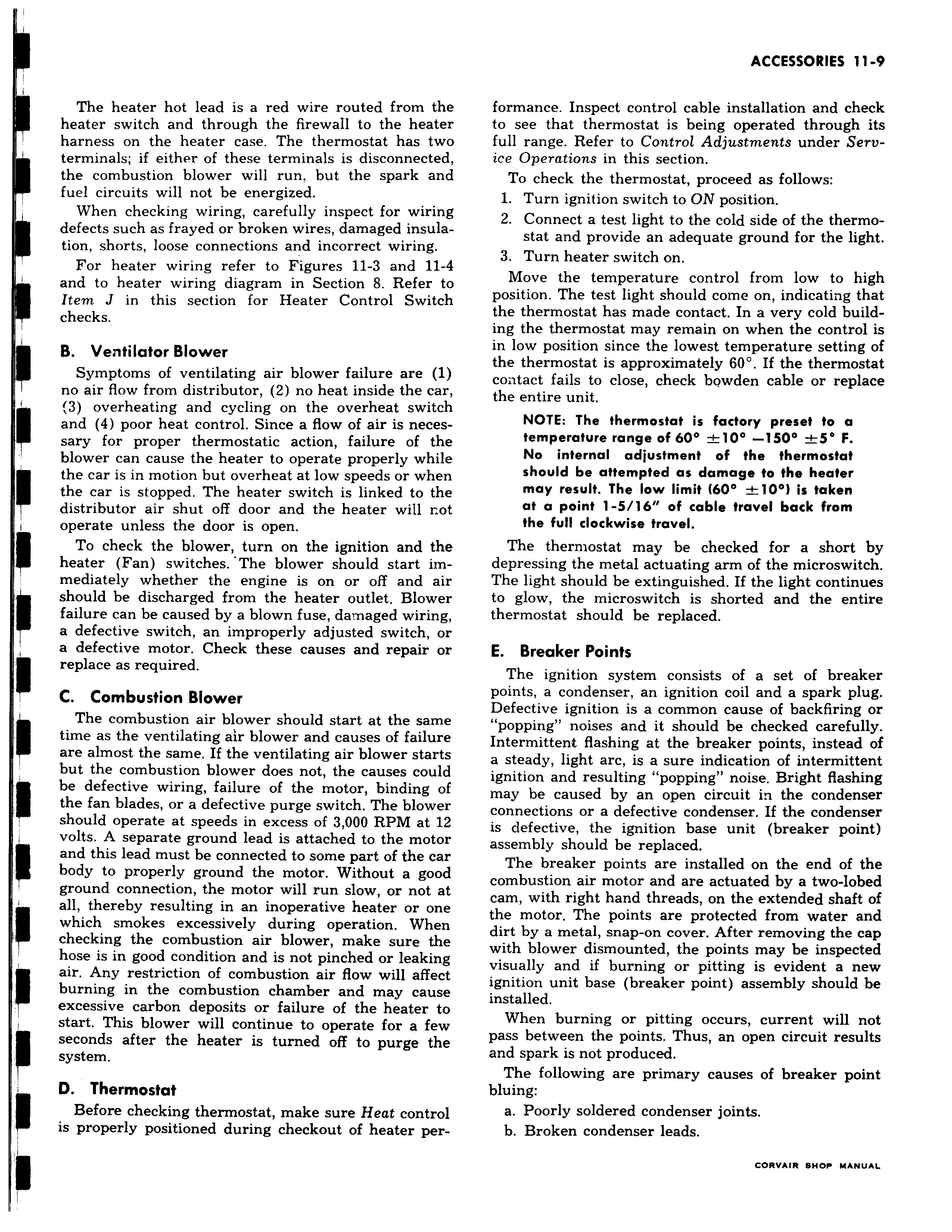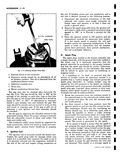Jeep Parts Wiki | Ford Parts Wiki
Home | Search | Browse
Prev

 Next
Next
The heater hot lead is a red wire routed from the heater switch and through the firewall to the heater harness on the heater case The thermostat has two terminals if either of these terminals is disconnected the combustion blower will run but the spark and fuel circuits will not be energized When checking wiring carefully inspect for wiring defects such as frayed or broken wires damaged insulation shorts loose connections and incorrect wiring For heater wiring refer to Figures 11 3 and 11 4 and to heater wiring diagram in Section 8 Refer to Item J in this section for Heater Control Switch checks I B Ventilator Blower Symptoms of ventilating air blower failure are 1 no air flow from distributor 2 no heat inside the car 3 overheating and cycling on the overheat switch and 4 poor heat control Since a flow of air is necessary for proper thermostatic action failure of the blower can cause the heater to operate properly while the car is in motion but overheat at low speeds or when the car is stopped The heater switch is linked to the distributor air shut off door and the heater will not operate unless the door is open To check the blower turn on the ignition and the heater Fan switches The blower should start immediately whether the engine is on or off and air should be discharged from the heater outlet Blower i failure can be caused by a blown fuse damaged wiring a defective switch an improperly adjusted switch or a defective motor Check these causes and repair or replace as required C Combustion Blower The combustion air blower should start at the same time as the ventilating air blower and causes of failure are almost the same If the ventilating air blower starts but the combustion blower does not the causes could be defective wiring failure of the motor binding of the fan blades or a defective purge switch The blower should operate at speeds in excess of 3 000 RPM at 12 volts A separate ground lead is attached to the motor and this lead must be connected to some part of the car body to properly ground the motor Without a good ground connection the motor will run slow or not at I all thereby resulting in an inoperative heater or one which smokes excessively during operation When checking the combustion air blower make sure the hose is in good condition and is not pinched or leaking air Any restriction of combustion air flow will affect burning in the combustion chamber and may cause excessive carbon deposits or failure of the heater to start This blower will continue to operate for a few seconds after the heater is turned off to purge the system D Thermostat I Before checking thermostat make sure Heat control is properly positioned during checkout of heater per formance Inspect control cable installation and check to see that thermostat is being operated through its full range Refer to Control Adjustments under Service Operations in this section To check the thermostat proceed as follows 1 Turn ignition switch to ON position 2 Connect a test light to the cold side of the thermostat and provide an adequate ground for the light 3 Turn heater switch on Move the temperature control from low to high position The test light should come on indicating that the thermostat has made contact In a very cold building the thermostat may remain on when the control is in low position since the lowest temperature setting of the thermostat is approximately 60 If the thermostat contact fails to close check bowden cable or replace the entire unit NOTE The thermostat is factory preset to a temperature range of 60 10 150 5 F No internal adjustment of the thermostat should be attempted as damage to the heater may result The low limit 60 10 is taken at a point 1 5 16 of cable travel back from the full clockwise travel The thermostat may be checked for a short by depressing the metal actuating arm of the microswitch The light should be extinguished If the light continues to glow the microswitch is shorted and the entire thermostat should be replaced E Breaker Points The ignition system consists of a set of breaker points a condenser an ignition coil and a spark plug Defective ignition is a common cause of backfiring or popping noises and it should be checked carefully Intermittent flashing at the breaker points instead of a steady light arc is a sure indication of intermittent ignition and resulting popping noise Bright flashing may be caused by an open circuit in the condenser connections or a defective condenser If the condenser is defective the ignition base unit breaker point assembly should be replaced The breaker points are installed on the end of the combustion air motor and are actuated by a two lobed cam with right hand threads on the extended shaft of the motor The points are protected from water and dirt by a metal snap on cover After removing the cap with blower dismounted the points may be inspected visually and if burning or pitting is evident a new ignition unit base breaker point assembly should be installed When burning or pitting occurs current will not pass between the points Thus an open circuit results and spark is not produced The following are primary causes of breaker point bluing a Poorly soldered condenser joints b Broken condenser leads

 Next
Next